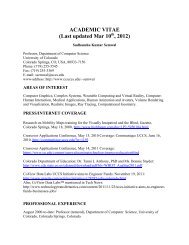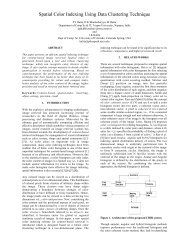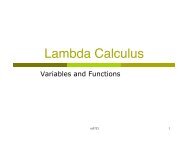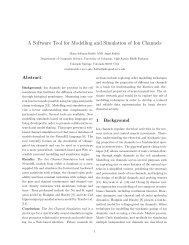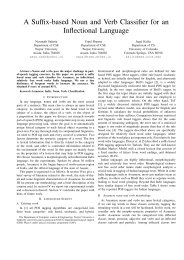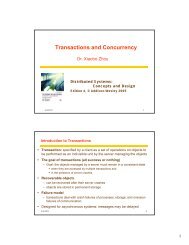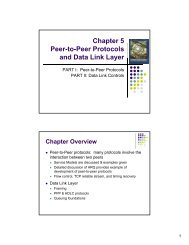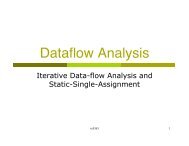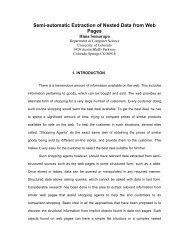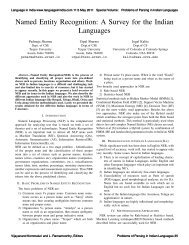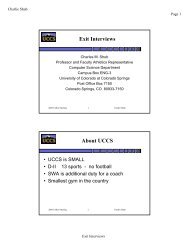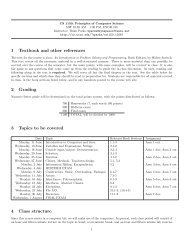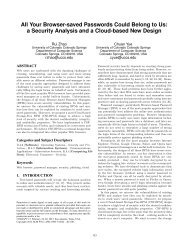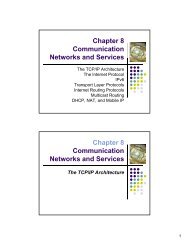A Dictionary Based POS Tagger for Morphologically Rich Language
A Dictionary Based POS Tagger for Morphologically Rich Language
A Dictionary Based POS Tagger for Morphologically Rich Language
Create successful ePaper yourself
Turn your PDF publications into a flip-book with our unique Google optimized e-Paper software.
A <strong>Dictionary</strong> <strong>Based</strong> <strong>POS</strong> <strong>Tagger</strong> <strong>for</strong> <strong>Morphologically</strong><br />
<strong>Rich</strong> <strong>Language</strong><br />
No Author Given<br />
No Institute Given<br />
Abstract. In this paper we present a dictionary based part of speech (<strong>POS</strong>) tagger<br />
<strong>for</strong> Assamese, an inflectional, relatively free word order Indic language. The main<br />
contribution of this paper is a <strong>POS</strong> tagger based on linguistic rules, that may work<br />
well morphologically rich languages with a strong case marking system. We have<br />
obtained an overall accuracy of 90%.<br />
1 Introduction<br />
Part of speech (<strong>POS</strong>) tagging is one of the main steps of any natural language processing<br />
task. It is a process of automatically assigning accurate part of speech tags to each<br />
word of a sentence. Though there are a number of methods to <strong>POS</strong> tagging, the set<br />
of <strong>POS</strong> tags themselves are language dependent as each language has its own distinct<br />
characteristics. Two factors determine the syntactic category of a word. The first is<br />
lexical in<strong>for</strong>mation directly related to the category of the word and the other is the<br />
contextual in<strong>for</strong>mation related to the environment of the word. [1] classified all <strong>POS</strong><br />
tagging algorithms into three basic categories, viz., rule based, stochastic, and hybrid.<br />
Most taggers have originally been developed <strong>for</strong> English and later adapted to other<br />
languages.<br />
Among Indo-Aryan languages, Sanskrit is a purely free word order language [2],<br />
but some other Indo-Aryan languages like Hindi, Bengali and Assamese have partially<br />
lost the free word ordering in the course of evolution. In fixed word order languages,<br />
position plays an important role in identifying the word category whereas this is not true<br />
<strong>for</strong> relatively free word order languages. Most Indian languages are morphologically<br />
rich, inflection being pre-dominant. In this report we use Assamese as the target<br />
language <strong>for</strong> all our experiments.<br />
In the next section, we describe prior work in <strong>POS</strong>-tagging of morphologically rich<br />
languages. Section 3 describes some relevant linguistic characteristics of Assamese.<br />
We describe available <strong>POS</strong> tagsets <strong>for</strong> Assamese in Section 4. In sections 5 and 6,<br />
we describe our approach and experimental results, respectively. Section 7 discusses<br />
evaluation metrics <strong>for</strong> the tagger and Section 8 concludes our paper.<br />
2 Literature Survey<br />
Techniques <strong>for</strong> building <strong>POS</strong> taggers fall under two broad approaches, supervised and<br />
unsupervised. Both supervised and unsupervised tagging can be of three sub-types.
They are rule based, stochastic and neural network based. Each of these methods<br />
has its own pros and cons. During the last two decades, many different types of<br />
taggers have been developed, especially <strong>for</strong> corpus rich languages such as English<br />
and Turkish. In this paper, we are interested in dictionary based <strong>POS</strong> tagging. [3]<br />
developed a dictionary based morphology driven <strong>POS</strong> tagger <strong>for</strong> five morphologically<br />
rich languages Romanian, Czech, Estonian, Hungarian, and Slovene and concluded that<br />
an approach based on morphological dictionaries is a better choice <strong>for</strong> inflectionally<br />
rich languages. [4] reported a morphology driven rule based <strong>POS</strong> tagger <strong>for</strong> Turkish,<br />
using a combination of handcrafted rules and statistical learning. [5] reported a<br />
hybrid morphology based <strong>POS</strong> tagger <strong>for</strong> Persian where they combine the features of<br />
probabilistic and rule-based taggers to tag Persian unknown words.<br />
Due to relative free word order, agglutinative nature, lack of resources and<br />
the general lateness in entering the computational linguistics field, reported tagger<br />
development work on Indian languages is relatively scanty. Among published works,<br />
Dandapat [6] developed a hybrid model of <strong>POS</strong> tagging by combining both supervised<br />
and unsupervised stochastic techniques. Avinesh and Karthik [7] used conditional<br />
random fields (CRF) and trans<strong>for</strong>mation based learning. The heart of the system<br />
developed by Singh et al. [8] <strong>for</strong> Hindi was the detailed linguistic analysis of morphosyntactic<br />
phenomena. Saha et al. [9] developed a system <strong>for</strong> machine assisted <strong>POS</strong><br />
tagging of Bangla corpora. Pammi and Prahllad [10] developed a <strong>POS</strong> tagger and<br />
chunker using decision <strong>for</strong>ests. This work explored different methods <strong>for</strong> <strong>POS</strong> tagging<br />
of Indian languages using sub-words as units. [11] tried out a morphology driven <strong>POS</strong><br />
tagger <strong>for</strong> Manipuri language with accuracy 65% <strong>for</strong> single tagged correct words. We<br />
have only one reported evidence of supervised part of speech tagging <strong>for</strong> Assamese [12]<br />
with accuracy nearly 87%.<br />
3 Linguistic Characteristics of Assamese<br />
Though Assamese is relatively free word order, predominant word order is SOV<br />
(subject-object-verb). In Assamese, secondary <strong>for</strong>ms of words are <strong>for</strong>med through<br />
affixation (inflection and derivation), and compounding. Affixes play a very important<br />
role in word <strong>for</strong>mation. Affixes are used in the <strong>for</strong>mation of relational nouns and<br />
pronouns, and in the inflection of verbs with respect to number, person, tense, aspect<br />
and mood. For example, Table 1 shows how a relational noun (deutA: father) is<br />
inflected depending on number and person.<br />
There are 5 tenses in Assamese, namely, present, past, future, present perfect and<br />
past perfect tense [13]. Besides these, every root verb changes with case, tense, person.<br />
In Table 2 we present some possible <strong>for</strong>ms of the root verb (kr: to do). The following<br />
paragraphs describe just a few of many characteristics of Assamese text that make the<br />
tagging task complex.<br />
– Suffixation of nouns is very extensive in Assamese. There are more than 100<br />
suffixes <strong>for</strong> the Assamese noun. These are mostly placed singly, but sometimes<br />
in sequence after the root word.<br />
– We need special care <strong>for</strong> honorific particles like dAngrIyA. Assamese<br />
and other Indian languages have a practice of adding particles such as deu,
Person Singular Plural<br />
1 s t My father Our father<br />
2 n d Your father Your father<br />
2 n d , Familiar Your father Your father<br />
3 r d Her father Their father<br />
Table 1. Personal definitives are inflected on person and number<br />
Present<br />
karo kar karaka karA<br />
Past<br />
karilo karili karile karilA<br />
Future<br />
karim karibi kariba karibA<br />
Present P.<br />
karicho karicha kariche karichA<br />
Past P.<br />
karichilo karichili karichil karichilA<br />
Causative —–<br />
karAbA karowAok karowA<br />
Table 2. Verbs are conjugated/inflected on person and number<br />
dAngrIyA, mahodaya, mahodayA, mahAsay,<br />
mahAsayA, etc., after proper nouns or personal pronouns. They are added to<br />
indicate respect to the person being addressed.<br />
– Use of <strong>for</strong>eign words is also common in Assamese. Often such words are used<br />
along with regular suffixes of Assamese. Such <strong>for</strong>eign words will be tagged as per<br />
the syntactic function of the word in the sentence.<br />
– Some prepositions or particles are used as suffix if they occur after nouns, personal<br />
pronouns or verbs. For example,<br />
TF: Sihe goisil.<br />
Actually (he) is a particle, but it is merged with the personal pronoun (si).<br />
– An affix denoting number, gender or person, can be added to an adjective or other<br />
category word to create a noun word. For example,<br />
TF : DhuniyAjoni hoi aAhisA.<br />
Here (dhuniyA) is an adjective, but after adding feminine definitive the<br />
whole constituent becomes a noun word. Table 3 shows some other examples of<br />
<strong>for</strong>mation of derived words in Assamese.
Prefix Stem Suffix Category Example<br />
- NN V B<br />
- V B V B<br />
- V B NN<br />
- V B A DJ<br />
- NN A DJ<br />
- A DJ NN<br />
- A DJ A DV<br />
V B - V B<br />
V B V B<br />
NN - NN<br />
NN - NN<br />
Table 3. Formation of derivational words in Assamese<br />
– Even conjunctions can be used as other parts of speech.<br />
TF : Hari aAru Jadu bhAyek kokAyek.<br />
ET : Hari and Jadu are brothers.<br />
TF : JowAkAlir ghotonAtowe bishoitok aAru adhik rahashyajanak kori tulile.<br />
ET : The incident last night has made the matter more mysterious.<br />
The word (aAru) shows ambiguity in these two sentences. In the first, it is<br />
used as conjunction and in the second, it is used as adjective of adjective.<br />
Fig. 1. Assamese noun inflection model
4 Assamese <strong>POS</strong> Tagset<br />
Xobdo 1 , an Assamese online dictionary project had developed a <strong>POS</strong> tagset 2 <strong>for</strong> all<br />
Northeast Indian languages. This tagset contains only 15 tags (Table 4). It groups<br />
all case endings, prefixes and suffixes into adposition. Though Assamese has a rich<br />
system of particles, Xobdo excludes particles other than the ones <strong>for</strong> interjection<br />
and conjunction. Another tagset 3 developed at Tezpur University solely <strong>for</strong> Assamese<br />
includes 172 tags. But this tagset is too large and has separate tags <strong>for</strong> general case<br />
markers as well as very specific noun case markers. For example the tag NCM is<br />
used <strong>for</strong> nominative case marker and CN1 and CNS1 are used <strong>for</strong> nominative singular<br />
common noun and nominative plural common noun, respectively. In this work, we<br />
follow the <strong>POS</strong> guidelines of the AnnCora (Bharati et al. 2006)[14], Penn treebank<br />
tagset 4 and MSRI-JNU Sanskrit tagset 5 . We use the same tags as in the Penn treebank<br />
when possible, so that they arel easily understandable to all annotators. The tags<br />
designed during this project <strong>for</strong> Assamese are shown in Table 5.<br />
Major <strong>POS</strong> Minor <strong>POS</strong><br />
1<br />
Common Noun<br />
2 Proper Noun<br />
3 Material Noun<br />
Noun<br />
4 Verbal Noun<br />
5 Abstract Noun<br />
6 Pronoun -<br />
7<br />
Proper Adjective<br />
8 Verbal Adjective<br />
Adjective<br />
9 Adjective of Adjective<br />
10 Adverb<br />
11 Transitive Verb<br />
Verb<br />
12 Intransitive Verb<br />
13<br />
Ad-position<br />
14 Others Interjection<br />
15 Conjunction<br />
Table 4. Xobdo’s tagset<br />
Our <strong>POS</strong> tagset covers the following lexical items:<br />
1. Single word tokens: These are the common words in the vocabulary, e.g., nouns,<br />
verbs, adjectives, etc.<br />
1 http://xobdo.org<br />
2 http://xobdo.org/dic/help/pos.php<br />
3 http://tezu.ernet.in/¾nlp/posf.pdf<br />
4 http://www.ims.uni-stuttgart.de/projekte/CorpusWorkbench/CQP-<br />
HTMLDemo/PennTreebankTS.html<br />
5 http://sanskrit.jnu.ac.in/corpora/MSR-JNU-Sanskrit-Guidelines.htm
Symbol 1st level 2nd level<br />
1 NN Noun<br />
Common<br />
Proper<br />
Material<br />
Abstract<br />
Verbal<br />
Time Indicative<br />
Verb Indicative<br />
2 PN Pronoun<br />
Personal<br />
Reflexive<br />
Reciprocal<br />
3 V B Verb<br />
Main<br />
Auxiliary<br />
Causative<br />
4 RB Adverb<br />
Time<br />
Location<br />
Manner<br />
Adjective<br />
5 NOM<br />
Demonstrative<br />
Nominal Modifier<br />
Quantifier<br />
Pre-nominal<br />
Conjuction<br />
Disjunction<br />
6 PAR Particle Exclamatory<br />
Vocative<br />
Particle<br />
7 PSP Post-position<br />
Case Marker<br />
Classifier<br />
Plural Marker<br />
8 QH Question word<br />
Interrogative Pronoun<br />
Interrogative Particle<br />
9 RDP Reduplication<br />
Reduplicative<br />
Onomatopoetic<br />
Echo Word<br />
Cardinal<br />
10 NUM Number<br />
Ordinal<br />
Date<br />
Time<br />
11 SPS Special symbol<br />
12 PUN Punctuation<br />
13 UN K Unknown word<br />
Table 5. Assamese hierarchical tagset<br />
2. Named entities of various types: Names of people, topological items, titles of films,<br />
company names, scientific names, <strong>for</strong>mulas, etc. Sometimes such lexical material<br />
is surrounded by inverted comma or brackets.
3. Compound word tokens .<br />
4. Abbreviations.<br />
5. Punctuations.<br />
(1) and (2) above include items that belong to common dictionaries. (3) and (4)<br />
contain items that refer to real world entities and (5) contains text <strong>for</strong>matting items.<br />
The design of our annotation scheme does not rely only on linguistic assumptions<br />
of traditional Assamese grammar, but also on the output needed <strong>for</strong> further linguistic<br />
processing of data.<br />
5 Our Approach<br />
The declension of an Assamese noun is given in Table 1. Assamese verbs and nouns are<br />
open class word categories. Assamese pronoun, particle, adjective and adverb classes<br />
are small and closed. So we can easily tag them. Assamese nouns are inflected with<br />
case markers (CM), plural markers (PM) and classifiers (CL). See examples below.<br />
1. = [root] + [CM]<br />
2. = [root] + [PM]<br />
3. = [root] + [CL]<br />
4. = [root] + [CM] + [CM]<br />
5. = [root] + [CM] + [CL]<br />
6. = [root] + [PM] + [CM]<br />
7. = [root] + [PM] + [CM] + [CL]<br />
5.1 Corpus<br />
We use a part of the EMILLE Assamese text corpus of nearly 2.6M words jointly<br />
developed by Lancaster University and CIIL-Mysore. Though the texts are in Unicode<br />
<strong>for</strong>mat, it required a lot of preprocessing. Here are some examples of errors we had to<br />
correct in the Unicodified EMILLE corpus.<br />
1. Bengali ra occurs in the corpus instead of Assamese .<br />
2. occurs where should and vice versa.<br />
3. An unrecognized character occurs where Assamese should.<br />
4. If second character of a conjunct is ba, then it disappears.<br />
5. There are many patternless spelling mistakes.<br />
We corrected as many errors as possible errors in the texts programatically and by<br />
extensive manual checking.<br />
5.2 Pre-processing<br />
In this phase, we tokenized our corpus. For tokenizing we consider white space as word<br />
separator and and a punctuation symbol ( ,?,!) as sentence terminator. Some problems<br />
we face during preparation of the corpus are listed below.
1. Detecting boundaries <strong>for</strong> some words such as and . Many place<br />
names are written in two ways, sometime with space and sometime without space.<br />
2. Irregularities in placing hyphens with reduplicative words: Reduplication is a<br />
special phenomenon in most Indian languages. Here, either the same word is<br />
written twice <strong>for</strong> indicating emphasis, deriving a category from another category<br />
(<strong>for</strong> example, ); or some nonsense word is used after a regular lexical<br />
word indicating the sense ‘etc’ (<strong>for</strong> example, ); or some tonally similar<br />
lexical word is used after a regular lexical word (<strong>for</strong> example, ). Sometimes<br />
hyphens are used between the two tokens and sometimes, not.<br />
3. Sometimes adverbs such as are written as , that is, without<br />
hyphens.<br />
4. Phrases such as are sometime written as . The complete<br />
phrase is considered as a single token, if it is written as .<br />
5.3 <strong>Dictionary</strong><br />
In our dictionary file, we store words, corresponding tags and whether they are inflected.<br />
A word is not inflected means the word is a root word. The simple way is to search<br />
the corpus <strong>for</strong> a dictionary word and its all possible combinations of affixes. Here we<br />
assume that all inflected dictionary words are 3 or more characters long. We can get all<br />
possible suffix sequence in<strong>for</strong>mation <strong>for</strong> noun from Figure 1. Similarly, suffix sequence<br />
<strong>for</strong> verbs can also be determined. A Java module searches all possible suffix sequences<br />
of a dictionary word and tag them.<br />
Words Number of entries<br />
Prefix 25<br />
Pronoun 89<br />
Suffix 110<br />
Particle 162<br />
Adverb 392<br />
Verb 881<br />
Adjective 3942<br />
Noun 4855<br />
Total 10456<br />
Table 6. <strong>Dictionary</strong> In<strong>for</strong>mation. 20 Assamese prefixes originate from Sanskrit, and other 5<br />
prefixes are of native origin [15]<br />
We store 102 suffixes <strong>for</strong> noun and 27 suffixes <strong>for</strong> verb. Our dictionary file contains<br />
only 10456 entries with tags. The dictionary is used primarily <strong>for</strong> reducing ambiguity.<br />
In Assamese, most words less than 4 characters long have more than one meaning [16].<br />
Our dictionary stores all root words and their corresponding tags, and all words which<br />
show ambiguity at word level and their corresponding tags. We maintain another file of<br />
suffixes that inflect nouns and verbs.
Algorithm 1: Algorithm <strong>for</strong> dictionary based <strong>POS</strong> tagging.<br />
Input: A dictionary file, a suffix file and a corpus crps<br />
Output: Tagged Corpus<br />
1 Read dictionary and suffix file and store it in separate array<br />
2 <strong>for</strong> Each token in the corpus crps do<br />
3 if the token is in dictionary file then<br />
4 Tag it with corresponding tag against the dictionary element.<br />
5 end<br />
6 else if The token ends with any element of suffix file then<br />
7 Tag the token with corresponding tag against the suffix.<br />
8 end<br />
9 else if The token starts with any element of prefix file then<br />
10 Tag the token with corresponding tag against the prefix.<br />
11 end<br />
12 Check whether tagged token satisfies the handcrafted rules or not.<br />
13 end<br />
Our tagging algorithm is described as Algorithm 1. We used Java to implement<br />
this algorithm. The results obtained are shown in Table 7. To resolve ambiguities such<br />
as noun-adjective ambiguity, noun-verb ambiguity, and adjective-adverb ambiguity, we<br />
used a simple rule base. Some of the rules we use are listed below.<br />
1. Adverbs always precede verbs and adjectives precede nouns.<br />
2. Words ending with are generally adverbs.<br />
3. Words ending with plural markers or definitives are always noun.<br />
4. Except single constituent sentences, particles do not occur in the initial position of<br />
a sentence.<br />
The strength of our approach is based on affix in<strong>for</strong>mation regarding words and<br />
categories of root words. We resolve ambiguity at the context level also. Suppose we<br />
get more than one tag <strong>for</strong> a specific token. In such a case, we check the previous token<br />
t 1 and using a handcrafted rule we mark the token t 2 and check the next token t 3 . We<br />
backtrack to t 2 to determine whether it is correct considering the tag on t 3 . To some<br />
extent, this simple procedure covers contextual in<strong>for</strong>mation also. However, a problem<br />
will arise if t 3 has also more than one tag.<br />
6 Results<br />
The results obtained are given in Table 7. In our corpus file there are 190897 numbers<br />
of sentence and total 1560677 words.<br />
6.1 Handling OOV<br />
The in<strong>for</strong>mation of morphological features and contextual features are used to resolve<br />
the OOV. Morphological features like affix in<strong>for</strong>mations and other context rule<br />
determined the the tag against the word.
<strong>POS</strong> Tag Number Correct Accuracy<br />
NN 148829 128670 86.45<br />
PN 14662 14654 99.94<br />
NOM 26916 26184 97.28<br />
RB 3813 3802 99.71<br />
V B 10585 9554 90.25<br />
NUM 1549 1549 100<br />
PAR 17711 17676 99.80<br />
PUN 37954 37954 1<br />
PSP 27 27 100<br />
Other 54 54 100<br />
Total Sentences 190897<br />
Total Words 1560677<br />
OOV 205385<br />
Table 7. Obtained results<br />
Fig. 2. Example Output<br />
Let us consider the output text in Figure 2. Here four words, viz.,<br />
(government), (metric), (intermediate) and (degree) are marked<br />
as OOV. All the four words are English words written in Assamese script without a<br />
morphological marker. There<strong>for</strong>e the algorithm cannot detect the category and mark<br />
them as unknown words. In the same figure, the word is also a English word<br />
written in Assamese script and marked as noun because the English word<br />
(college) is associated with the genitive case marker . A manual verification of the<br />
tagged text has been carried out after the tagging process is over. Table ?? summarizes<br />
the results obtained and verified corrected result is given in Table 7.<br />
7 Evaluation and Discussion<br />
For calculating precision and recall, the <strong>for</strong>mulas are as follows.<br />
P recision =<br />
Recall =<br />
N umber of tagged words<br />
N umber of total words<br />
N umber of cor rectly tagged word<br />
N umber of tagged words
To combine precision and recall into a single measure of over all per<strong>for</strong>mance, we can<br />
measure the F-measure is as follows-<br />
F -measure = 2 ∗ P ∗ R<br />
P + R<br />
Table ?? shows the precision, recall and F-measure values. As this is the first step<br />
towards developing a rule based approach <strong>for</strong> Assamese <strong>POS</strong>-tagging, we intend to<br />
investigate if modifying some of our rules or creating additional rules increases the<br />
per<strong>for</strong>mance of the tagger.<br />
Author <strong>Language</strong><br />
Accuracy<br />
[4] Turkish 98%<br />
[11] Manipuri 69%<br />
[3] Romanian, Czech, Hungarian 94.23%<br />
Estonian, Slovene<br />
[17] Polish 88%<br />
Ours Assamese 90%<br />
Table 8. Compared result with other dictionary based works.<br />
We compare our result with published results in other languages in Table 8. There<br />
were aproximately 24K words in the lexicon in the work of [4] whereas [11] use only<br />
2.1K root words in the dictionary file. As mentioned above we use a lexicon of size<br />
10.5K in the dictionary and obtain 90% accuracy. [3] repoted 3.72% error rate <strong>for</strong><br />
Czech, 8.20% <strong>for</strong> Estonian, 5.64% <strong>for</strong> Hungarian, 5.04% <strong>for</strong> Romanian and 5.12% <strong>for</strong><br />
Slovene.<br />
8 Conclusion<br />
From our experiments, we observe that dictionary based tagging gives promising results<br />
<strong>for</strong> a morphologically rich Indic language. The F-measure values obtained are nearly<br />
90%. There is hardly any other reported work on <strong>POS</strong> tagging of Assamese. Hence<br />
our work assumes significance. We strongly feel that this approach combined with<br />
techniques such as HMM, ME, CRF, etc., will produce even better results.<br />
References<br />
1. Jurafsky, D., Martin, J.H.: SPEECH and L A NGUAGE PROCESSING, An Introduction to<br />
Natural <strong>Language</strong> Processing, Computational Linguistics, and Speech Recognition. Pearson<br />
Education (2000)<br />
2. Ray, P.R., V., H., Sarkar, S., Basu, A.: Part of speech taggging and local word grouping<br />
techniques <strong>for</strong> natural language parsing in Hindi<br />
3. Hajič, J.: Morphological tagging: Data vs. dictionaries. In: Proceedings of the 1st North<br />
American chapter of the Association <strong>for</strong> Computational Linguistics conference. (2000)
4. Oflazer, K., Kuruöz, I.: Tagging and morphological disambiguation of Turkish text. In:<br />
Proceedings of 4th Conference on A NLP. (1994)<br />
5. Shamsfard, M., Fadaee, H.: A hybrid morphology-based pos tagger <strong>for</strong> Persian. In:<br />
Proceedings of the the International Conference on <strong>Language</strong> Resources and Evaluation.<br />
(2008)<br />
6. Dandapat, S.: Part-of-speech tagging and chunking with maximum entropy model. In:<br />
Proceedings of Workshop on Shallow Parsing <strong>for</strong> South Asian <strong>Language</strong>s (SPSA L). (2007)<br />
7. PVS, A., G, K.: Part-of-speech tagging and chunking using Conditional Random Field and<br />
Trans<strong>for</strong>mation based learning. In: Proceedings of IJC AI-07 workshop on Shallow Parsing<br />
<strong>for</strong> South Asian <strong>Language</strong>s (SPSA L). (2007)<br />
8. Singh, S., Gupta, K., Shrivastava, M., Bhattacharyya, P.: Morphological richness offsets<br />
resource demand-experiences in constructing a <strong>POS</strong> tagger <strong>for</strong> Hindi. In: In Proceedings of<br />
the COLING/ACL on Main conference poster. (2006)<br />
9. Saha, G.K., Saha, A.B., Debnath, S.: Computer assisted Bangla words <strong>POS</strong> tagging. In:<br />
Proc. International Symposium on Machine Translation NLP & TSS. (2004)<br />
10. Pammi, S.C., Prahallad, K.: <strong>POS</strong> tagging and chunking using Decision Forests. In:<br />
Proceedings of Workshop on Shallow Parsing <strong>for</strong> South Asian <strong>Language</strong>s (SPSA L). (2007)<br />
11. Singh, T.D., Bandyopadhyay, S.: Morphology driven Manipuri pos tagger. In: Proceedings<br />
of the IJCNLP-08 Workshop on NLP <strong>for</strong> Less Privileged <strong>Language</strong>s. (2008)<br />
12. Saharia, N., Das, D., Sharma, U., Kalita, J.: Part-of-Speech <strong>Tagger</strong> <strong>for</strong> Assamese Text. In:<br />
Proceedings of ACL/IJCNLP 2009. (2009)<br />
13. Goswami, G.C.: Asamiya Vyakaran Pravesh. Bina Library (2000)<br />
14. Bharati, A., Chaitanya, V., Sangal, R.: Natural <strong>Language</strong> Processing: A Paninian Perspective.<br />
Prentice-Hall, India (1993)<br />
15. Goswami, U.: Asamiya Bhashar Vyakaran. Mani Manik Prakash (2001)<br />
16. Sharma, U.: Unsupervised Learning of Morphology of A Highly Inflectional <strong>Language</strong>. PhD<br />
thesis, Tezpur University (2007)<br />
17. Galus, S.: <strong>Dictionary</strong>-based part-of-speech tagging of polish. In: Intelligent In<strong>for</strong>mation<br />
Processing and Web Mining, Springer Berlin / Heidelberg (2005)



